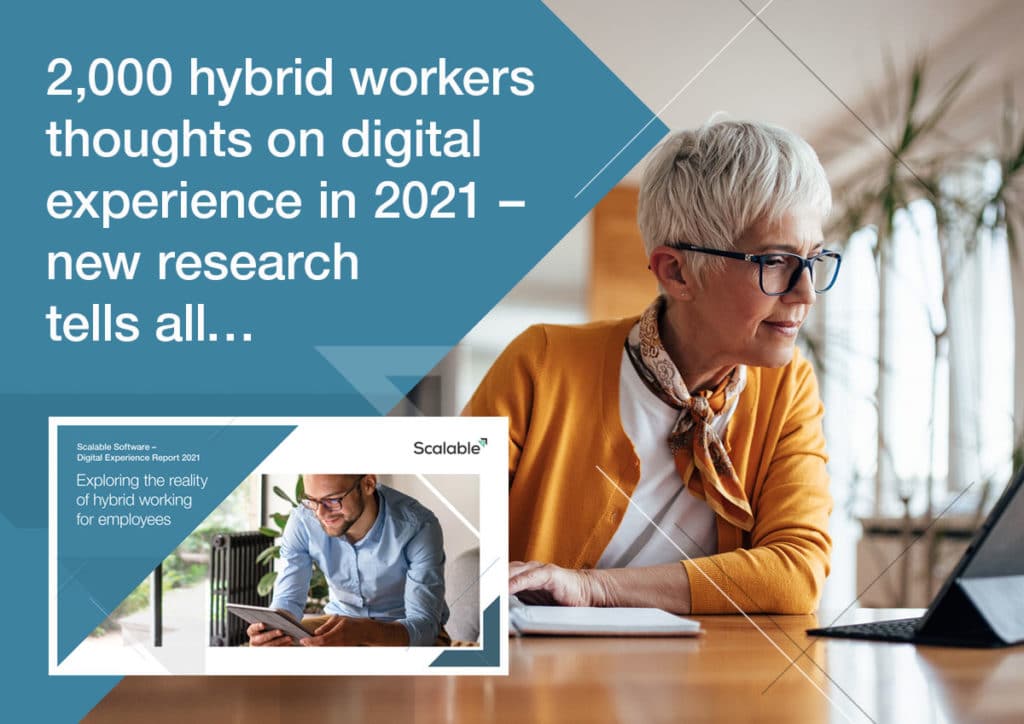What 2,000 Hybrid Workers Think of the State of Digital Experience in 2021
-
September 7, 2021
- Posted by: Pete Summers

Scalable’s New Research Tells All
In September, we’re going to see a mass return of employees to offices. However, with 85% of homeworkers wanting the option of working both at home and in the office, the majority of organizations will be operating within a hybrid model. As such, the need to make these models as robust as possible has never been more important.
Against this backdrop of change, Scalable decided to go straight to the source. Today, we’ve launched our Digital Experience Report 2021, for which we surveyed 2,000 UK hybrid workers. In this report, we dig into workers’ experiences, their pain points, and what they want from their employers, as well as their IT and HR departments. Let’s take a look at some of the key findings.
Lost time is lost money
The first notable finding is the sheer scale of lost time and money businesses experience when they fail to put in place the right technology and processes to facilitate hybrid working. Our survey found that hybrid workers waste around 6.96 hours per week as they struggle with a lack of access to technology and with technology that doesn’t work. This results in a whopping £2.1bn annual productivity loss for UK PLC.
On average, employees are also working an extra 2.2 weeks a year because of poorly designed workflows, a lack of user-friendly applications, and because they are not equipped with the right technology. These findings underline how damaging the effects of poor digital experience can be – not just on the business’s bottom line but on the well-being of staff as well.
IT has work to do to understand employees
Our survey also revealed a split in how well hybrid workers feel their organization’s IT department understands their needs. While 51% feel that their IT department provides a personalized service and understands the way they work, 49% feel IT treats most of them the same without understanding how they work as individuals.
This lack of understanding means that when employees don’t feel technology fits their needs, they can unwittingly thwart digital transformation projects. Almost a third (32%) of respondents haven’t used new technology on offer because they felt existing tech was already better than new deployments, and almost a quarter (23%) say the user experience isn’t good enough.
Workforce analytics is the key
All of this is testament to the importance of IT and HR having access to data that lets them fully understand employee journeys. This will enable teams to assess the uptake of tools, how they’re being used, and where adoption needs to be improved. Understanding the employee journey also helps to reveal where time is being lost because technology is not up to scratch, and where the end-user experience is being impacted. This empowers IT and HR to work together to improve employee experiences and well-being, and put in place sustainable and successful hybrid working models.
As our CTO Mark Devereux says, “Hybrid working has become a mainstay of 21st century life. It’s time for a new approach to the world of work. Organizations need sophisticated workforce analytics that bridge the gap between IT and HR. When businesses understand the digital journey in detail, they can make changes to measure, optimize and transform the employee experience, and stop time and money being wasted.”
To find out more, download the full report here.
To learn how exceptional hybrid working employee experiences drive engagement, collaboration, and increased productivity, check out this on-demand webinar.